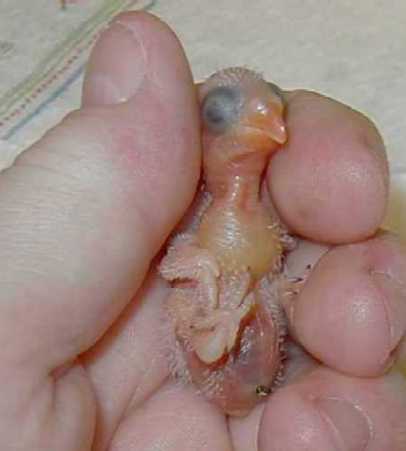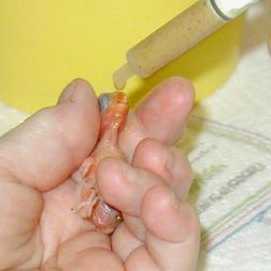Hand feeding any baby Lovebird is a commitment,
but hand feeding a baby Lovebird from day 1 is a commitment, plus a labor of love!
Hatchling babies are very tiny, in addition to being very uncooperative.
The most important thing to consider when feeding a baby this young is timing.
Parent Lovebirds feed their young around the clock for the first 7-10 days, and
the hand feeder must also do this. Hatchlings are fed every 2 hours round the
clock for the first 5 days. The schedule changes after day 5 and I will discuss
this later.
The items needed for a hatchling are the same as for an older baby but there are a few extras that are necessary with a day 1.
- Hand feeding formula (22/9 - 22% protein, 9% fat)
- Lactobacillus (for digestive bacteria)
- Papaya (for digestive enzymes)
- Enfalyte or Pedialyte (suggested for the first 5 days)
- Small "O" ring syringe (I prefer 3 cc) or a small tapered tip eyedropper
- Small container to mix formula
- Thermometer (to check temperature of the formula)
- Disinfectant to clean syringes and utensils when finished (10% bleach solution
or Oxyfresh)
Most baby Lovebirds are taken from their parents when they are about 14 days old,
so digestive bacteria and enzymes have already been established in their systems
by their parents. This happens within the first 4-5 days. Hand fed hatchlings
do not get this benefit from their parents, so the hand feeder has to add these
items. I use Enfalyte instead of plain water because hatchlings tend to dehydrate
easily. (I prefer Enfalyte to Pedialyte because it is rice based.) A small syringe
gives me much better control when I'm trying to feed a very tiny baby.
Proper feeding temperature is still 106F-108F. Mom feeds at the same temperature, regardless of age. With hatchlings, feeding amount is measured in drops rather than by cc. If the very first feeding is 6-8 drops, that is a lot! This picture shows how full the crop should be for a day 1 lovebird baby. Note that the crop is full and the formula stops at the base of the throat.
How Much to Feed a Hatchling Baby Lovebird
Deciding when to feed a day 1 chick for the first time can be tricky. If I do an assisted hatch and choose to feed the baby myself, I wait about 6 hours before I feed. Feeding too soon can kill the chick. If the baby has been with mom and I discover she isn't feeding, enough time has usually passed were it's safe to feed immediately.
For the first couple of feedings, I use just Enfalyte or Pedialyte. This is to
make sure that the digestive system is functioning before I feed anything that
is harder to digest. As soon as I see that the baby has eliminated 3 separate
times, I know I can begin feeding formula. As each formula is different, you will
need to follow the mixing instructions on the individual packaging.
There are several things to remember when feeding a day 1 baby.
- Hatchlings are very small and tend to be uncooperative. Very young baby lovebirds are fed on their backs at this age because they have very heavy bodies and their legs won't support their weight. Until the baby gets used to the feeding routine, it will tend to squirm and wiggle.
- Hatchlings need to learn how to eat from a syringe. This is not normal for them and it can take up to a half dozen feedings before the baby gets the idea. Since I'm right-handed, I feed from the side closest to me, the baby's right side. Left-handed would be the just the opposite. I do this so that I can see what is going on. The tip of the syringe will not actually go into the baby's mouth, so very small drops will find their way to the back of the baby's throat. Even though I'm using a very small syringe, many times more will be on the baby than in the baby! I watch the baby's crop to determine when I've fed enough. Only drops that go into the mouth count! The picture directly below shows positioning when feeding a day 1 baby.
- Formula will cool quicker when you use a small syringe. I always have a container of hot water (110F-115F) that I can dip my syringe in so that I can keep the formula warm. Between drops, I put at least the tip of the syringe in the container of hot water. Formula will also cool in the very short time that it takes to go from the tip of the syringe to the baby's mouth.
- When hand feeding a baby this young, always watch the baby's mouth as you
feed/as it eats. If the drops of formula are a bit too big, it's very easy
for the baby to aspirate (inhale liquid into the lungs) and die.
Once the baby is 5 days old, I thicken the formula so that I can extend the feedings to roughly every 3 hours. I stay on the 3 hour schedule until the baby is 2 weeks old, giving just one 4 hour break sometime between midnight and 5:00 a.m. to allow the crop to completely empty. Lovebird parents feed round the clock for roughly the first 2 weeks so I mimic their schedule. Even after the first 2 weeks, my first feeding of the day is between 5:00 a.m. and 6:00 a.m. This is also parent schedule. I allow 2 weeks for the digestive bacteria/digestive enzymes to populate the baby's system. Once the baby is 14 days old, I find that lactobacillus and papaya are no longer necessary unless I have a digestive problem with the chicks.


